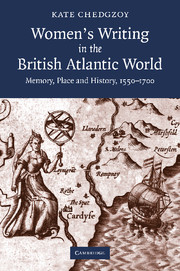Book contents
- Frontmatter
- Contents
- Acknowledgements
- Introduction: ‘A place on the map is also a place in history’
- Chapter 1 ‘The rich Store-house of her memory’: The metaphors and practices of memory work
- Chapter 2 ‘Writing things down has made you forget’: Memory, orality and cultural production
- Chapter 3 Recollecting women from early modern Ireland, Scotland and Wales
- Chapter 4 ‘Shedding teares for England's loss’: Women's writing and the memory of war
- Chapter 5 Atlantic removes, memory's travels
- Conclusion
- Notes
- Bibliography
- Index
Introduction: ‘A place on the map is also a place in history’
Published online by Cambridge University Press: 22 September 2009
- Frontmatter
- Contents
- Acknowledgements
- Introduction: ‘A place on the map is also a place in history’
- Chapter 1 ‘The rich Store-house of her memory’: The metaphors and practices of memory work
- Chapter 2 ‘Writing things down has made you forget’: Memory, orality and cultural production
- Chapter 3 Recollecting women from early modern Ireland, Scotland and Wales
- Chapter 4 ‘Shedding teares for England's loss’: Women's writing and the memory of war
- Chapter 5 Atlantic removes, memory's travels
- Conclusion
- Notes
- Bibliography
- Index
Summary
On 10 July 1666, Anne Bradstreet's house in Andover, Massachusetts burned down. In a poem commemorating the loss of her home, she characterizes the smouldering ruins as a much-revisited site of memory, keeping all that she has lost painfully alive in her mind:
When by the ruins oft I past
My sorrowing eyes aside did cast,
And here and there the places spy
Where oft I sat and long did lie:
Representing a beloved home as a tenderly domestic memory theatre, Bradstreet makes an orderly inventory of the places in the ruined house where fond reminiscence belonged. Each of the objects carefully placed within it – ‘Here stood that trunk, and there that chest’ (l. 29) – summons up memories of love, hospitality, storytelling and sociable conversation. The house is presented not merely as a domestic space, but also as a site of familial memory and history. The poem itself is the textual trace of the continuing existence in memory of the house and the loving relationships associated with it.
‘Some verses upon the burning of our house’ was not published in Bradstreet's lifetime. Its survival as a memorial to the domestic history recalled in it was ensured when Anne Bradstreet's son Simon ‘[c]opied [it] out of a loose paper’ after her death, in an act of filial commitment to his mother's emotional and literary legacy.
- Type
- Chapter
- Information
- Women's Writing in the British Atlantic WorldMemory, Place and History, 1550–1700, pp. 1 - 15Publisher: Cambridge University PressPrint publication year: 2007

